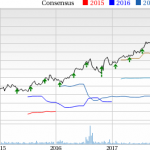Over the last few years, an improving domestic economy and rising demand for residential mortgages have favored the U.S. savings and loan industry. Rising income of Americans, along with relatively low interest rates, has supported the housing market by enhancing demand for residential mortgages. This has helped the industry grow over this period.
In fact, lesser regulatory supervision and an improving housing market, though at a slow pace, are anticipated to keep driving the industry’s growth in the upcoming quarters too. However, a rising rate environment will likely somewhat dampen loan demand, as consumers will try to avoid taking loans at higher rates. Particularly, weakness in revolving home equity loans may offset growth in the commercial and industrial (C&I), consumer and overall real estate loans to some extent.
For 2018 and after, multiple challenges will crop up for savings and loan companies, including legacy technologies, new competitors and an unbalanced customer base, in the course of undertaking better initiatives for significant growth. Thus, to remain competitive and reap profits in the rapidly-evolving market, these companies will ramp-up transition into diligently-focused, technology-driven and flexibly-operating institutions.
Industry Lags on Shareholder Returns
Looking at shareholder returns over the past couple of years, it appears that the broader economic recovery wasn’t enough for boosting investors’ confidence in the industry’s growth prospects.
The Zacks Savings and Loan Industry, a 33-stock group within the broader Zacks Finance Sector, has underperformed the S&P 500 and its own sector over the past two years.
While the stocks in this industry have collectively gained 24.1%, the Zacks S&P 500 Composite and Zacks Finance Sector have rallied 34.7% and 25.2%, respectively.
Two-Year Price Performance

Savings and Loan Stocks Trading Cheap
Thanks to the underperformance of the industry over the past two years, the valuation looks cheap now. One might get a good sense of the industry’s relative valuation by looking at its price-to-tangible book ratio (P/TBV), which is the most appropriate multiple for valuing finance companies because of large variations in their earnings results from one quarter to the next.
This ratio essentially measures a bank’s current market value relative to what it would be worth if all assets were sold, debt was paid and intangible assets were written off.
The industry currently has a trailing 12-month P/TBV ratio of 1.61, slightly below the median level over the past two years. When compared with the highest level of 1.77 in that period, there is apparently decent upside left.
However, the space looks pretty cheap when compared with the market at large, as the trailing 12-month P/TBV ratio for the S&P 500 is 11.05X and the two-year median level is 9.19X.



















Leave A Comment